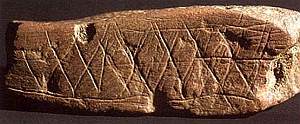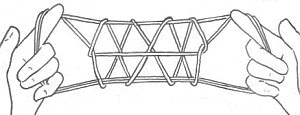The Algorithms of String
Cory Panshin on July 22, 2009Since I started blogging a couple of months ago, I have to some degree just been tossing in whatever catches my eye — but at the same time, my flights of speculation have been far from random. They all orbit around a small number of topics which I find of particular interest, and many of them grow out of a major project that I’ve been working at for many years.
The organizing principle of this project is the notion that human history has been structured by a progression of contending visions of the nature of the universe.
Each of these visions arises out of a unique area of human experience and practical knowledge and gradually acquires greater organization in the form of a theoretical framework that both explains that experience and extrapolates beyond it. Those extrapolations then become a rich source of culture innovation and creativity.
Eventually, though, theory hardens into dogma and vision into ideology. Then new visions arise to challenge and overthrow the old ones and to enjoy their own moment of cultural dominance before they are overthrown in in turn.
Even after being rejected, however, the older visions never vanish entirely. Every one of them leaves residual traces in the form of art and story and other symbolic expressions that are so powerful and archetypal that they continue to be maintained indefinitely.
Thanks to those traces, even the most ancient visions can still be identified and to some extent reconstructed — though with less certainty as you go further back in time. Much of what I’ve written here about prehistory and early civilizations reflects my ongoing attempt to identify the assumptions and theories and mythic elaborations associated with the very earliest visions.
Hardest of all to make out is the starting point, the very first human vision of existence, in part because it seems to predate even the earliest known myths. But there are certain components that can be tentatively assigned to it, working both from archaeology and from those elements in the earliest myths that seem to reflect a state of belief even older than the myths themselves.
Going by what can be deduced from those sources, the core principle of the initial vision appears to have involved transformation of the physical universe, expressed primarily in terms of alchemical operations employing fire and water.
As I suggested a couple of months ago in writing of the extraordinarily early invention of glue, not only has this kind of alchemical awareness now been firmly dated at 70,000 years ago, but there are hints that it may go back to the very beginning of our own species, some 180,000 years before the present day.
Just as important as glue to the dawning sense of a mutable reality, however, may have been string. Although it does not leave physical evidence in the archaeological record, there can be no doubt that string was an essential part of the early human toolkit — whether for carrying things around, holding things together, hanging meat up out of the reach of animals, or serving as belts to keep the first simple clothing in place.
But string is of little use without knots, and the tying of knots is an extraordinarily sophisticated operation, as anyone who has tried to teach the skill to a four year old will attest. Not only does it demand advanced hand-eye coordination, but it requires a firm intellectual grasp of both the specific pattern to be matched and the abstract sequence of steps needed to get there.
Knot-tying may well have been humankind’s first crash course in logical, step-by-step thinking — the initial step in the progression that led to science and logic and computer algorithms. But if that was so, then the graduate course in the use of string would have been the creation of string figures.
 String figures are obviously an extraordinarily ancient art-form. In fact, the earliest known work of art, which was discovered a few years ago in a cave in South Africa, appears to depict a string figure.
String figures are obviously an extraordinarily ancient art-form. In fact, the earliest known work of art, which was discovered a few years ago in a cave in South Africa, appears to depict a string figure.
This 70,000 year old artifact consists of a piece of ochre incised with a row of lozenge-like shapes. Its location and date place it within a few hundred miles and at most a few thousand years of those ancient tools which have been analyzed to reveal the use in their construction of an expertly brewed glue. Even the substance used for the artifact, ochre, is the same as one of the components of that glue, reinforcing the impression that they come from the same intellectual tradition.
 Aside from suggesting that the carving demonstrates “modern ways of thinking,” the archaeologists who have discussed it don’t seem to have much clue as what it might actually mean, with guesses ranging from “symbolic intent” to “meaningless doodles.” The simplest explanation, however, is that this was an attempt to give permanent form to the already ancient art of string figures.
Aside from suggesting that the carving demonstrates “modern ways of thinking,” the archaeologists who have discussed it don’t seem to have much clue as what it might actually mean, with guesses ranging from “symbolic intent” to “meaningless doodles.” The simplest explanation, however, is that this was an attempt to give permanent form to the already ancient art of string figures.
The present-day distribution of string figures further suggests that they must have been spread throughout the world by the first wave of humans to journey out of Africa. They are practiced by many of the archaic cultures which lie along that original migration route — in Africa, India, Indonesia, and among Native Americans — but the most elaborate examples are found in Australia, New Guinea, and the Pacific islands of Melanesia and Polynesia.
Americans and Northern Europeans are mainly familiar with the simple two-person cat’s cradle, which is also well-known in China, Korea, and Japan — but the single-person figures produced elsewhere are far more complex. All of us know that string figures are endlessly fascinating to the young, but most of us forget once we grow up just how astonishingly transformational the figures can appear.
You start with something entirely flat and uninspired — a simple loop of string. You then put it through a series of changes, each one of which is not only strange and complicated in itself but also strikingly different from the one before.
The maker becomes increasingly engrossed in the performance, which involves all five fingers of both hands and occasionally even the teeth. The spectators lean in eagerly, trying to follow the moves but never quite managing to keep up with the sleight-of-hand. And then, in a final climactic transformation, the entire elaborate structure is turned upside down or inside out to display a simple, recognizable object — a fish-spear, say, or two men carrying a boat.
In the public performance of string figures, we can discern the origins of art, of theater, and of stage magic — not to mention the kind of careful following of a script or recipe which is essential to everything from cooking to science to religious ritual.
It takes faith to work your way through the changes of a string figure, believing that you will emerge at the end with something beautiful and illuminating and not just a tangle of knots and snarls.
And that is only what is demanded of the performer. The people who first invented these figures — messing around with a length of string day after day, running through various permutations in search of that moment of inspired recognition — must have been operating on a level of abstraction and intuitive guidance as high as any present-day artist or scientist.
Even now, the idea of string has deep mythic resonances, ranging from the tiny vibrating particles envisioned by string theory to the vast cosmic strings that align the galaxies. There is a mystery about string that has never been forgotten.
Related:
A listing of all my posts on deep prehistory can be found here.
A general overview of the areas of interest covered at this blog can be found here.
A chronological listing of all entries at this blog, with brief descriptions, can be found here.
Read the Previous Entry: The Efflux of OsirisRead the Next Entry: Female Magic




